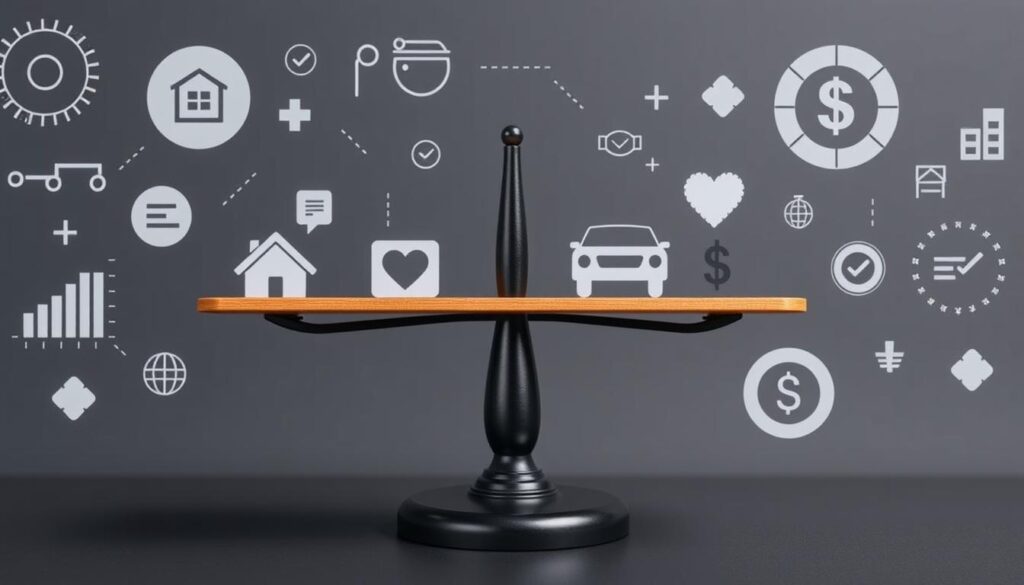Finding the right insurance can seem overwhelming. But, it’s key to protect your assets and secure your future. This guide will help you understand insurance lumologs. We’ll cover the different types, how to know what you need, and find the best policy for you.
Key Takeaways
- Understand the various types of insurance lumologs and their specific coverage options
- Assess your unique insurance needs to ensure you have the right level of protection
- Explore cost-saving strategies to optimize your insurance coverage
- Learn how to navigate the claim process and ensure timely resolution
- Discover resources and tips for finding the most suitable insurance lumolog provider
Understanding Insurance Lumologs
In the world of insurance, an insurance lumolog is key to protecting people, businesses, and their assets. But what is an insurance lumolog, and what types are there? Let’s explore the basics.
What is an Insurance Lumolog?
An insurance lumolog is a detailed document that outlines an insurance policy’s terms and conditions. It gives info on coverage, limits, and what’s not covered. This document helps policyholders understand their insurance lumolog, policy coverage, and coverage options.
Types of Insurance Lumologs
There are many types of insurance lumologs, each for different needs and risks. The most common include:
- Property Lumologs: These cover physical assets like homes, vehicles, or business properties.
- Liability Lumologs: These protect against legal and financial issues from incidents or actions that harm others.
- Specialty Lumologs: These cover unique risks like professional liability, cyber security, or medical malpractice. They’re for specific industries or professions.
Knowing the different types of insurance lumologs is key to picking the right coverage. It ensures your assets and liabilities are well-protected.
“An insurance lumolog is the roadmap to your coverage, outlining the terms, conditions, and protections that your policy provides.”
Assessing Your Insurance Needs
Choosing the right insurance is key. You need to know what you need. This means looking at your assets, debts, and risks. This way, you can pick the right coverage for peace of mind.
Evaluating Your Assets
First, list your valuable things. This includes your home, cars, stuff you own, and investments. Knowing their value helps you choose the right coverage for them.
Assessing Your Liabilities
Then, think about what you owe. This includes debts, mortgages, and legal stuff. Knowing these helps you pick insurance that protects your money and keeps you safe.
Identifying Potential Risks
Look at the risks you face. This could be because of your job, where you live, or personal stuff. This helps you choose the right insurance, like liability or health insurance, to keep you and your family safe.
By looking at your assets, debts, and risks, you can pick the best insurance. This way, you’re ready for anything that comes your way.
| Asset | Value | Liability | Potential Risk |
|---|---|---|---|
| Home | $350,000 | Mortgage: $200,000 | Natural disasters, fire, theft |
| Vehicle | $25,000 | Loan: $10,000 | Accidents, theft |
| Personal Belongings | $50,000 | None | Theft, damage |
| Investments | $100,000 | None | Market fluctuations, fraud |
“Protecting your assets and managing your risks should be at the forefront of your insurance planning.”
Evaluating Policy Coverage
Choosing the right insurance policy is key. You need to check the coverage options carefully. This will show you what’s essential and if extra coverage is needed.
Essential Coverage Options
The core of any insurance policy includes key elements. These are:
- Liability coverage: This protects you from costs if you damage someone else’s property or hurt them.
- Collision coverage: It pays for repairs or a new car if you crash.
- Comprehensive coverage: This covers damage from theft, vandalism, or natural disasters.
Optional Add-Ons
Insurance policies also have extra options. These can make your policy better. Some examples are:
- Roadside assistance: It helps with problems like flat tires or dead batteries.
- Rental car coverage: It pays for a rental while your car is fixed.
- Gap insurance: It covers the loan difference if your car is totaled.
By looking at policy coverage, you can make your insurance fit your needs. This ensures you have the right protection.
| Coverage Type | Description | Importance |
|---|---|---|
| Liability | Covers damage or injury to others | Essential |
| Collision | Covers damage to your vehicle | Essential |
| Comprehensive | Covers non-collision-related incidents | Essential |
| Roadside Assistance | Provides help with mechanical issues | Optional |
| Rental Car Coverage | Covers the cost of a rental car | Optional |
| Gap Insurance | Covers the difference between loan and value | Optional |
Factors Affecting Insurance Costs
Insurance costs can change a lot based on different factors. Knowing these key elements helps figure out your premium. Let’s look at the two main things that affect insurance costs: risk assessment and premium calculations.
Risk Assessment
Insurers look at how much risk they take on when they cover you. They consider your age, where you live, your driving history, job, and health. The more risk you seem to have, the more you’ll pay for insurance.
Premium Calculations
Insurers use special rules to figure out your premium. They look at your risk level, how much coverage you want, and your deductibles. Policies with more coverage or lower deductibles usually cost more.
| Factor | Impact on Insurance Costs |
|---|---|
| Age | Younger drivers typically pay higher premiums due to increased risk. |
| Location | Areas with higher crime rates or natural disaster risks often have higher insurance costs. |
| Driving History | A clean driving record can lead to lower insurance premiums, while accidents and traffic violations can increase costs. |
| Coverage Limits | Higher coverage limits typically result in higher insurance premiums. |
| Deductibles | Policies with lower deductibles generally have higher premiums. |
Understanding these factors can help you choose the right insurance. This way, you can find coverage that fits your needs and budget.

Choosing the Right Insurance Lumolog
Choosing the right insurance lumolog is key to your financial health. It’s important to consider several factors to get the right coverage at a good price.
First, think about what coverage you need. What kind of coverage do you require? What are your deductibles and limits? Knowing this helps you find the best insurance for you.
Then, look at the policy selection from different providers. Choose a provider with many options, including customizable plans. This way, you can find a plan that fits your unique needs.
- Check the coverage limits and deductibles of each plan.
- Look at the exclusions and limitations to know what’s covered and what’s not.
- Compare premium costs to find a plan that’s affordable for you.
Lastly, pick an insurance lumolog that balances coverage and cost well. Don’t cut out important coverage for a cheaper premium. But also, watch your budget and look for ways to save without losing protection.
“Selecting the right insurance lumolog is a critical decision that can provide financial security and peace of mind in times of need.”
By carefully considering your needs, evaluating policy options, and finding the right balance, you can choose an insurance lumolog that meets your needs and protects your financial future.
Comparing Insurance Providers
Choosing an insurance provider is a big decision. It’s important to look at their underwriting guidelines, customer service, and policy terms. This helps you pick a reliable and reputable company.
Underwriting Guidelines
Underwriting guidelines are key in deciding who gets insurance and what they pay. Each company has its own rules. Knowing these can help you choose better.
Customer Service
Good customer service is crucial. Look at what others say about the company’s service. This tells you how well they handle problems and how friendly they are.
| Insurance Provider | Underwriting Guidelines | Customer Service Rating |
|---|---|---|
| ABC Insurance | Comprehensive, flexible underwriting criteria | 4.8 out of 5 stars |
| XYZ Insurance | Strict underwriting guidelines with limited exceptions | 3.9 out of 5 stars |
| Omega Insurance | Balanced underwriting approach with personalized assessments | 4.5 out of 5 stars |
By looking at underwriting and customer service, you can choose wisely. This ensures you get the right insurance for you.
Understanding Policy Terms
When you pick an insurance policy, it’s key to read the terms and conditions well. Knowing these details helps you understand what’s covered, what’s not, and any limits. This way, you can make a smart choice and avoid surprises later.
First, look at the policy terms. These terms explain what your policy covers, like accidents or damage. It’s vital to understand these terms to see if they fit your needs.
Then, check the coverage details. This part tells you what your policy includes, like liability or medical costs. Knowing what’s covered helps you see if the policy is right for you.
Also, don’t miss the exclusions and limitations. Exclusions are things not covered by your policy. Limitations are the max amount the insurer will pay for certain claims. Knowing these helps spot any coverage gaps.
| Policy Term | Definition |
|---|---|
| Deductible | The amount you pay out-of-pocket before the insurance coverage kicks in. |
| Premium | The recurring fee you pay to maintain your insurance coverage. |
| Copay | The fixed amount you pay for a covered service or treatment. |
| Limit | The maximum amount the insurance provider will pay for a covered claim. |
By understanding policy terms, coverage, exclusions, and limits, you can choose wisely. This ensures your insurance policy really protects you.
Navigating the Claim Process
Understanding the claim process is key to getting the most from your insurance. This guide will walk you through filing a claim and solving any problems that come up. Knowing how to navigate the claim process ensures your insurance is there for you when you need it.
Filing a Claim
To start the claim process, you need to contact your insurance company. You can call, go online, or use a mobile app. Be ready to give details like the date, where it happened, and what happened. Also, have any supporting documents or evidence ready.
- Gather all relevant information about the incident or event
- Contact your insurance provider to initiate the claim process
- Provide the required details and any supporting documentation
- Follow up on the status of your claim and respond to any requests for additional information
Claim Resolution
After you file your claim, your insurance company will review it. They might send someone to check the damage, talk about the settlement, or approve the claim. Being patient and cooperative can help the process go smoothly and quickly.
| Claim Resolution Stages | Description |
|---|---|
| Assessment | Your insurance provider will evaluate the details of your claim and determine the appropriate next steps. |
| Negotiation | If necessary, your insurance provider will work with you to negotiate the settlement amount. |
| Approval | Once the claim is approved, your insurance provider will process the payment. |
By understanding the claim process and being prepared, you can boost your chances of a successful claim. This ensures your insurance coverage protects you when you need it most.
Cost-Saving Strategies
Understanding insurance can be tough, but smart shoppers can save a lot. You can get discounts and adjust your coverage to cut costs. This way, you can save money without losing protection.
Unlock Policy Discounts
Insurance companies give discounts for good reasons. They reward loyal customers and encourage safe behavior. Here are some common discounts:
- Bundling multiple policies (e.g., home and auto) with the same insurer
- Maintaining a clean driving record or claims-free history
- Installing security systems or safety features in your home or vehicle
- Enrolling in defensive driving courses or participating in telematics programs
Optimize Your Coverage Levels
Finding the right balance in insurance is key. You want enough coverage but not too much. Check your coverage often and adjust as needed. This can help you save money.
| Coverage Type | Optimal Level | Potential Cost Savings |
|---|---|---|
| Auto Liability | Minimum required by state law | Up to 20% on premiums |
| Collision and Comprehensive | Adjust deductibles based on vehicle value | 10-15% on premiums |
| Homeowners Insurance | Ensure coverage matches current home value | 5-10% on premiums |
By using smart strategies, you can save on insurance without losing protection. Stay informed, compare, and work with your provider to find the best balance.
“The key to finding the perfect insurance policy is to strike a balance between comprehensive coverage and cost-effective premiums.”

Finding the Right Insurance Lumolog
Finding the right insurance lumolog can seem hard. But, with the right help, you can find what you need. You can use online tools or talk to an insurance agent. Both ways have their benefits when picking the best insurance lumolog.
Online Resources
The internet has made it easier to find insurance. Many websites and tools let you compare and get quotes. These sites are a great place to start looking for your insurance.
Working with an Agent
Online tools are good for a quick look, but an agent offers more. They know a lot about insurance and can help you choose. They make sure you get the right coverage at a good price.
Whether you use online tools or an agent, understanding your needs is key. This way, you can find insurance that protects you and fits your budget.
“Finding the right insurance lumolog is essential to protecting your financial well-being. Take the time to explore all your options and make an informed decision.”
Conclusion
We hope this guide on choosing the right insurance lumolog has helped you understand more. It covers everything from knowing your insurance needs to saving money. This guide aims to equip you with the knowledge to make a smart choice.
Getting the right insurance is key to protecting your assets and managing risks. By learning about different insurance options and what they cover, you can pick the best one for you. This choice should fit your financial situation and needs.
Having the right insurance gives you peace of mind and financial security. It prepares you for the unexpected. Use the tips and resources from this guide to find the best insurance for you. This will help protect your future.
FAQ
What is an insurance lumolog?
An insurance lumolog is a contract that protects you from risks and liabilities. It outlines the coverage, terms, and conditions of your policy.
What are the different types of insurance lumologs?
There are several types of insurance lumologs. Property insurance covers damage to your home or belongings. Liability insurance protects you from lawsuits. Specialty insurance covers unique risks, like professional liability or cyber threats.
How do I assess my insurance needs?
To assess your insurance needs, think about your assets, liabilities, and risks. Consider the value of your property and the level of your liabilities. This will help you choose the right coverage for your financial interests.
What are the essential coverage options in an insurance lumolog?
Essential options include property damage, liability protection, and personal injury coverage. Your policy may cover your home, vehicle, or business. You can also add extra coverage, like flood insurance or identity theft protection.
What factors affect the cost of an insurance lumolog?
The cost depends on your risk level, coverage limits, and claims history. Insurers use these factors to set your premium.
How do I choose the right insurance lumolog?
Start by figuring out what coverage you need. Look at policy options, coverage levels, deductibles, and costs. Compare quotes and review underwriting guidelines to make a good choice.
How do I navigate the insurance claim process?
Be ready to give detailed information about the incident and damages. Follow the insurer’s claim process, which may include submitting documents and working with a claims adjuster. Understanding your policy and working with your insurer can make the process smoother.
What cost-saving strategies can I use for my insurance lumolog?
To save money, look for discounts, like bundling policies or having a good claims history. You can also adjust your coverage levels and deductibles to lower your premiums.
Where can I find resources to help me find the right insurance lumolog?
Online resources, like insurance comparison websites and educational platforms, can help. Working with an experienced insurance agent can also provide personalized guidance and support.



